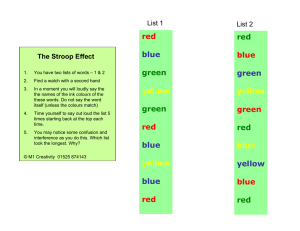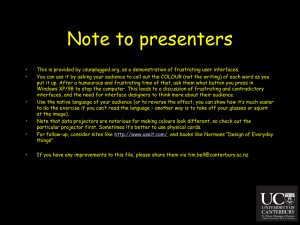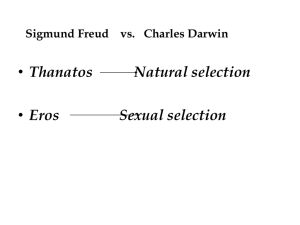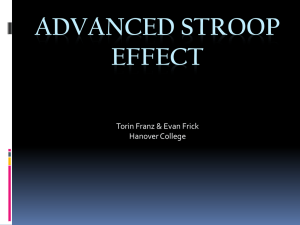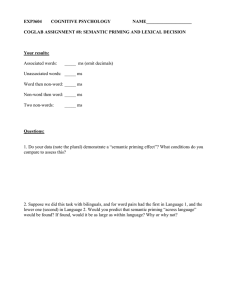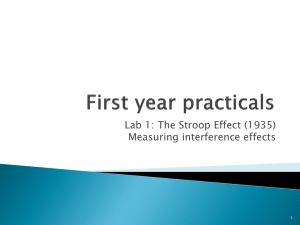Dyslectic Priming & Stroop Effect: Reducing Cognitive Interference
advertisement
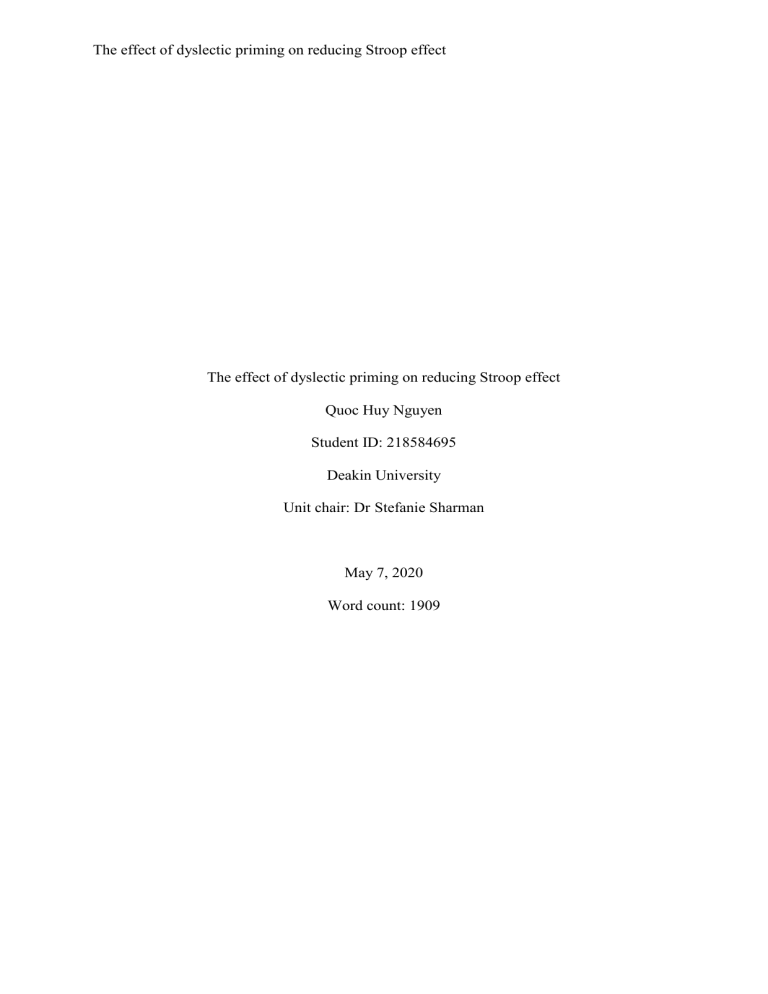
The effect of dyslectic priming on reducing Stroop effect The effect of dyslectic priming on reducing Stroop effect Quoc Huy Nguyen Student ID: 218584695 Deakin University Unit chair: Dr Stefanie Sharman May 7, 2020 Word count: 1909 The effect of dyslectic priming on reducing Stroop effect Abstract The current study is intended to determine whether environmental priming, such as dyslectic priming, affect to the reduce of Stroop effect since research suggests that automatic behaviours are likely interfered by suggestion based on environmental priming. Stroop effect demonstrates the delaying in reaction when the mismatch happens in stimuli since the reading or understanding meaning of words is known as an automatic process. Four hundred and twenty participants enrolled in HPS203 or HPS773 in 2020 were asked to complete a Stroop task in both congruent and incongruent trials. After that, dyslectic priming is delivered to participants through answering a short question, and participants were then asked to perform another 12 Stroop trials to test how dyslectic priming affect to Stroop effect. The results indicate that the reaction time is faster in a congruent trial, and there is a smaller gap of reaction time between two groups (congruent and incongruent groups) after the intervention of dyslectic priming. Implications of this environmental priming effect for automaticity are discussed, as is whether dyslectic priming is effective in reducing Stroop effect. These results support the hypothesis that dyslectic priming affects the automatic processing associated to Stroop effect, specifically inhibition. These findings also open the question to if the impact of social priming on automatic behaviours is immense in society. The effect of dyslectic priming on reducing Stroop effect Psychologically, Stroop effect is a way to demonstrate a delay in reaction time of tasks because of a mismatch in stimuli. This effect is named after John Ridley Stroop after his discovery in 1935. The Stroop effect refers to the finding that the reaction time to the incongruent stimuli was significantly longer than the reaction time to the congruent stimuli. In other words, Stroop effect facilitates with responding congruent trial and interferes with responding in an incongruent trial. Regarding the definition of congruence and incongruence, The effect of dyslectic priming on reducing Stroop effect congruence is defined as the identity between the person’s ideal self and experience while incongruence shows the difference between experience and awareness. Notably, automatic processes play an essential role in directly generating actual behaviours. The high level of inhibitory control can inhibit the behaviour caused by automatic activation and produces more deliberate behaviour. Thus, inhibitory control is necessary to maintain safety behaviour when automatic processes are dominant. Besides, inhibitory control is measured by the Stroop task. Hence, the well understands of the Stroop effect is effective in controlling automatic processes. According to the experiment 2 of Stroop (1935), one hundred participants underwent the “Naming colour test” (NC), 24 solid squares with different colours in order are used instead of words. Participants are also given the other task known as NCWd (‘Naming colour of word test where the colour of the print and the word are different’). Specifically, they had to name the colours of the print where the words did not match with the colours (e.g. the word ‘yellow’ was printed in red). The result of the experiment shows a comparison of reaction time between two tasks. The figure of the mean of reaction time for naming colour in the NCWd test increases nearly 74 per cent compared to the NC test (110.3 compared to 63.3, respectively). The increase of reaction time in NCWd test indicates that the discrepancy between word and colour of the print (incongruent stimuli) interfered the activity of naming colours. Because word reading known as an automatic process that does not need constant conscious guidance or controlled attention. In terms of the experiment of Raz, Kirsch, Pollard and Nitkin-Kaner (2006), the study aimed to determine the impact of the suggestion on reducing Stroop effect. They chose 25 proficient English readers (both genders) with a standard vision for the experiment. Then, candidates would be divided into two different groups, namely hypnosis condition and nohypnosis condition groups. Participants had to perform two Stroop tasks, namely once with The effect of dyslectic priming on reducing Stroop effect activation of suggestion and once without activation of suggestion. The suggestion in the experiment of Raz et al. (2006) is conducted by showing the crosshair at the centre of the screen. Participants needed to focus on a cross around two seconds before responding to the stimulus alternately. It is showed that the mean of reaction time in the inhibition Stroop effect group (incongruent-congruent) after receiving suggestion is around 60 per cent compared to those before receiving suggestion (77 and 76 against 132 and 116, respectively). Likewise, the mean of reaction time of incongruent-neutral group after receiving instruction is nearly half compared to those before receiving instruction (53 and 43 against 94 and 78, respectively). Results indicate the significant reduce of Stroop effect because of the suggestion such as impromptu scribbles. It is also implied that suggestion markedly disperses and inhibit automatic cognitive processes. Meanwhile, Bargh, Chen and Burrows (1996) emphasised that features of the environment possibly activate the stereotypes of social groups which lead to the automatic modification of social behaviour. Experiment 1 of this study examined the effect of traitpriming manipulations on behavioural change and social perception. In terms of methodology, 34 students from New York University were selected for an experiment as a course research requirement. Bargh et al. (1996) constructed three versions of trait-priming, namely the construct rude, the construct polite and the construct neutral. First of all, participants would be primed by completing 30 scrambled-item test with different versions depending on the given condition of participants. Particularly the test would contain some adjectives or verbs associated with the priming concept for rude and polite priming version, such as bother or disturb for rude group and respect or honour for a polite group. After that, participants would be taken to another room where confederate and experimenter did the trick, namely they tried to pretend to converse and ignored participants, to examine whether priming affects to automatic processes. The survey about the experience of the experiment The effect of dyslectic priming on reducing Stroop effect was given to participants for the last step. The elapsed time was recorded every moment when participants utilised words to interrupt and prove their presence or finished after 10 minutes. The percentage of participants who interrupted the conversation in the rude construct group was nearly twice the construct neutral group and tripled the polite construct group (with the figure of 62%, 37% and 18%, respectively) (Bargh et al., 1996). Participants primed with rudeness-stimuli tended to interrupt the conversation faster because they claimed that ignoring them was truly rude and unprofessional. Whereas, polite-primed candidates indicated that those actions were polite and patient. In a nutshell, the experiment implied that traits environment activated directly and automatically related social behaviours. Overall, the current study has utilised the information related to Stroop effect and how this effect relates to the dyslectic priming in the context of congruent and incongruent stimuli. The rationale of the study is getting further knowledge of the topic, namely the effect of dyslectic priming in reducing Stroop effect and automatic processes because automaticity possibly carries risk in many aspects of life. The current study aims to determine whether people can utilise environmental priming to against the Stroop effect. Regardings two hypotheses of the current study, the first hypothesis is that the reaction time for selecting in the first experiment (congruent) is faster than the other experiment (incongruent). It was also hypothesised that the reaction time of the incongruent group is likely faster after the intervention of dyslectic priming. Method Participants Four hundred and twenty participants completed the experiment. They were students enrolled in HPS203 and HPS773 during Trimester 1, 2020. Age and sex were not recorded. Materials and Procedure The effect of dyslectic priming on reducing Stroop effect Participants completed the experiment online. They completed a Stroop task in which they had to name the ink colour of each word presented on a computer screen. In incongruent trials, ink colour was different to the colour word (e.g., RED shown in green ink). In congruent trials, ink colour was the same as the colour word (e.g., YELLOW shown in yellow ink). Four colours were selected (blue, green, red and yellow); they appeared with equal frequency across trials. Participants were instructed to press the key on the keyboard that matched the ink colour. They were told to respond quickly and without making errors. Blue was represented by the “B” key, green was represented by the “G” key, red was represented by “R: key, and yellow was represented by the “Y” key. Participants completed 12 trials. Reaction times for correct responses were recorded for congruent and incongruent trials. After taking part in the Stroop task, participants were given dyslectic priming in the form of sentences to read and questions to answer. They were given 2 minutes to type their thoughts into a textbox to answer the questions at the end of the sentences. The sentences and questions were: ‘‘Mark is 25 years old and he suffers from very severe dyslexia. He cannot read or write at all; it can be said that Mark is completely illiterate. For the next 2 minutes, think and write about Mark’s everyday life. What does his daily routine look like? What are the things that he is good at and what are the things that he is bad at?’’ After 2 minutes, participants completed another 12 Stroop trials. Results Mean reaction times for correct responses on congruent and incongruent trials are shown in Table 1. Table 1. Mean reaction times for correct trials (ms) The effect of dyslectic priming on reducing Stroop effect Congruent trials Incongruent trials Before dyslectic priming 702 (21) 759 (22) After dyslectic priming 705 (20) 710 (21) Note. Figures in parentheses are standard deviations Two paired t-tests were conducted to determine whether there was a significant difference between reaction times for congruent vs incongruent trials before the dyslectic priming and after the dyslectic priming. Before priming, there was a significant difference in reaction time between the congruent and incongruent trials, t(419) = 5.41, p = .001. After priming, there was no significant difference in reaction time between the congruent and incongruent trials, t(419) = 1.21, p = .24. Discussion The aim of the current study is to identify whether how participants in both congruent and incongruent trials utilise the dyslectic priming against the Stroop effect. The first hypothesis the reaction time for naming the colour of a congruent group in first step is faster than the other group, namely incongruent group, is supported. Another hypothesis that the reaction time is likely faster in incongruent group after utilising the dyslectic priming while the decrease of reaction time is not recorded in the congruent group is also supported. Results show a significant gap between congruent and incongruent groups before the intervention of dyslectic priming (702 compared to 759, respectively). Thus, the current finding is consistent with experiment 2 of Stroop (1935), which reported that the mismatch in word and colour (incongruent stimuli) makes participants slower in naming colours. Besides, results also demonstrate the reduction in reaction time of incongruent group as well as the insignificant gap between two mentioned group after utilising dyslectic priming. These findings solidify The effect of dyslectic priming on reducing Stroop effect that instruction based on social priming and the decrease of Stroop effect shows a strong linkage to each other. Results can be further understood by the study of Bargh et at. (1996), in which the trait-priming manipulations associated with environmental features such as rude or polite attitude directly activate the automatical behaviours. The result of the experiment of Bargh et at. (1996) shows that contestants primed with environmental stimuli will react differently to a neutral group (faster or slower). Hence, the experiment of Bargh et al. (1996) shows the consistency with the result of the present study in determining the efficiency of priming to the automaticity. Likewise, the current findings are also consistent with Raz et al.’s study (2006), which demonstrated that the smaller Stroop effect after being primed in spite of the difference in priming. In term of the Stroop effect, it could be observed that participants reported the delay in their reaction to the naming colour task in an incongruent trial. In the current study, Stroop effect is performed by the participants and the utilised stimulus, which is semantically related to the mismatch in colours and words. The declaration of colours requires more cognitive effort while reading word considered as automatic process occurs almost effortlessly. The emergence of disparity between sources of information (incongruence) leads to the harder functioning of the brain in solving the essential difference. Therefore, in the incongruent trial, brain has to perform three different tasks; namely preventing reading word, processing word colour and resolving the mismatch between two sources of information, that make contestant’s response more slowly. At the second stage of the current study, participants were primed with a social priming concept of dyslexia. Dyslexia is known as a disorder that involves difficulty in reading; hence participants with dyslectic priming tend to behave similarly. Dyslectic priming creates an automatic change in behaviour which is match with the primed concept. Particularly this type of social priming decreases the activation of The effect of dyslectic priming on reducing Stroop effect automatic reading and increases the colour processing, henceforth the Stroop effect caused by the incongruent stimuli was eliminated after the intervention of dyslectic priming. Although the current study support participants by providing specific instructions and details about the experiment before beginning the procedure, the pre-practice test with unlimited time could help participants easily adapted to the stimuli of the experiment that possibly affect the overall results. This problem related to information memorisation has the potential to affect the ability of identification colours of prints, as some contestants could select the colour of print according to their memory when they practised before. Another limitation is the affect of uncontrolled variables when participants perform an experiment such as noise or light of a screen. These uncontrolled variables worked as interference that could have affected to reaction of contestants as well as results of the experiment. It is undeniable that these limitations may have impacted to results of the current study; thus, the experiment should be conducted and strictly controlled to eliminate any external validity of the study. For future research, a new test with a new priming stimulus may need to be devised to evaluate the function of the automaticity. Bargh et al. (2006) showed that different traitprimings associated with environmental features had desired effect in activating automatic processes. Henceforth, the priming could be changed and examined before utilising for the study. Besides, the elimination of any extravenous variables which likely affect results should be considered, as the control of the external environment. These suggestions will make the study have a higher accuracy of results as well as increase the validity and generalisation of the main aim of the study. In a nutshell, an individual’s cognitive processing speed is likely to become slower to incongruent stimuli than congruent stimuli. Besides, it is also found that the occurrence of interference is primarily linked to incongruent stimuli and has an accompanying impact in a The effect of dyslectic priming on reducing Stroop effect variety of social situation. The central message of the study that instructions based on social priming are genuinely useful in reducing the Stroop effect in the incongruent trial. Results of the current study support and solidify hypotheses about the Stroop effect that has utilised and enhanced the research conducted by Raz et al. (2006) and Bargh et al. (1996). The major implication of the findings is that the rational use of primings based on environmental features can reduce adverse effects, namely the Stroop effect, for automatic behaviours. Stroop effect is a critical phenomenon closely associated with automaticity; thus, it is crucial to widen and further this study. The effect of dyslectic priming on reducing Stroop effect References Bargh, J. A., Chen, M., & Burrows, L. (1996). Automaticity of social behavior: Direct effects of trait construct and stereotype activation on action. Journal of Personality and Social Psychology, 71(2), 230–244. doi: 10.1037/0022-3514.71.2.230 Raz, A., Kirsch, I., Pollard, J., & Nitkin-Kaner, Y. (2006). Suggestion Reduces the Stroop Effect. Psychological Science, 17(2), 91–95. doi: 10.1111/j.1467-9280.2006.01669.x Stroop, J. R. (1935). Studies of interference in serial verbal reactions. Journal of Experimental Psychology, 18(6), 643–662. doi: 10.1037/h0054651
